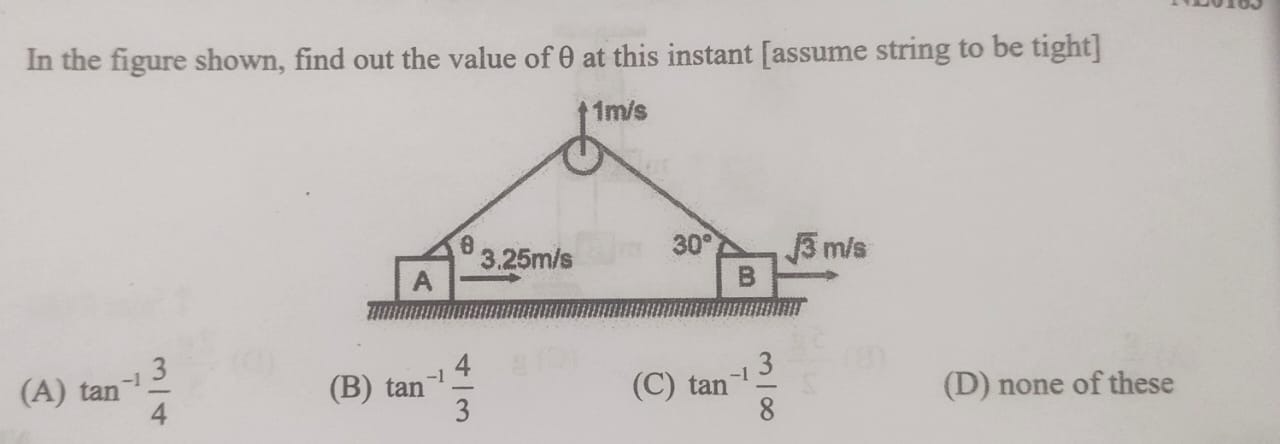Question
Question: In the figure shown, find out the value of $\theta$ at this instant [assume string to be tight] ...
In the figure shown, find out the value of θ at this instant [assume string to be tight]

tan−143
tan−134
tan−183
none of these
θ=tan−143
Solution
To find the value of θ, we use the principle of constraint motion for an inextensible string. The total length of the string remains constant.
Let LA be the length of the string segment connecting block A to the pulley, and LB be the length of the string segment connecting block B to the pulley. Let xA be the horizontal distance of block A from the vertical line passing through the pulley, and xB be the horizontal distance of block B from the vertical line passing through the pulley. Let h be the vertical height of the pulley from the ground.
The total length of the string L can be written as: L=LA+LB+constant (length over pulley) L=xA2+h2+xB2+h2+constant
Since the string is inextensible, its total length L is constant, so its time derivative is zero: dtdL=0
Differentiating the expression for L with respect to time t: 2xA2+h21(2xAdtdxA+2hdtdh)+2xB2+h21(2xBdtdxB+2hdtdh)=0 LAxAdtdxA+LAhdtdh+LBxBdtdxB+LBhdtdh=0
From the figure, we can relate the geometric terms to the angles: For the left side (block A): cosθ=LAxA sinθ=LAh
For the right side (block B): cos30∘=LBxB sin30∘=LBh
Now, let's relate the rates of change of coordinates to the given velocities: Velocity of block A, vA=3.25m/s, is to the right. Since xA is the horizontal distance from the pulley (assuming A is to the left), moving right means xA is decreasing. So, dtdxA=−vA. Velocity of block B, vB=3m/s, is to the right. Since xB is the horizontal distance from the pulley (assuming B is to the right), moving right means xB is increasing. So, dtdxB=vB. Velocity of the pulley, vP=1m/s, is upwards. So, dtdh=vP.
Substitute these into the differentiated length equation: (cosθ)(−vA)+(sinθ)(vP)+(cos30∘)(vB)+(sin30∘)(vP)=0 −vAcosθ+vPsinθ+vBcos30∘+vPsin30∘=0
Rearranging the terms: vP(sinθ+sin30∘)=vAcosθ−vBcos30∘
Now, substitute the given values: vA=3.25m/s=413m/s vB=3m/s vP=1m/s sin30∘=21 cos30∘=23
1(sinθ+21)=413cosθ−3(23) sinθ+21=413cosθ−23 sinθ+0.5=3.25cosθ−1.5 sinθ+0.5+1.5=3.25cosθ sinθ+2=3.25cosθ Multiply by 4 to clear the decimal/fraction: 4sinθ+8=13cosθ
We need to find θ. We can express this in terms of tanθ. Divide by cosθ (assuming cosθ=0): 4tanθ+cosθ8=13 This form is not directly solvable for tanθ.
Let's try to rearrange 4sinθ+8=13cosθ as 13cosθ−4sinθ=8. We know that sin2θ+cos2θ=1. From 4sinθ=13cosθ−8, square both sides: 16sin2θ=(13cosθ−8)2 16(1−cos2θ)=169cos2θ−208cosθ+64 16−16cos2θ=169cos2θ−208cosθ+64 185cos2θ−208cosθ+48=0
This is a quadratic equation in cosθ. Let x=cosθ. 185x2−208x+48=0 Using the quadratic formula x=2a−b±b2−4ac: x=2(185)208±(−208)2−4(185)(48) x=370208±43264−35520 x=370208±7744 To find 7744: 802=6400, 902=8100. Ends in 4, so unit digit is 2 or 8. Try 882=(90−2)2=8100−360+4=7744. So, 7744=88.
x=370208±88 Two possible values for cosθ: x1=370208+88=370296=185148=5×374×37=54 x2=370208−88=370120=3712
If cosθ=54, then sinθ=1−(4/5)2=1−16/25=9/25=53 (since θ is an acute angle in the context of the problem, sinθ>0). Let's check this pair in the equation 4sinθ+8=13cosθ: 4(53)+8=13(54) 512+8=552 512+40=552 552=552 This solution is consistent.
For cosθ=54 and sinθ=53, we have tanθ=cosθsinθ=4/53/5=43. So, θ=tan−1(43).
Let's check the second solution for cosθ=3712. If cosθ=3712, then sinθ=1−(12/37)2=372372−122=372(37−12)(37+12)=37225×49=375×7=3735. Check this pair in the equation 4sinθ+8=13cosθ: 4(3735)+8=13(3712) 37140+378×37=37156 37140+296=37156 37436=37156 This is false. So, cosθ=3712 is an extraneous solution introduced by squaring.
Therefore, the only valid solution is θ=tan−1(43).
Core Solution:
- Define the total length of the string L=xA2+h2+xB2+h2.
- Differentiate L with respect to time and set to zero: dtdL=0.
- Substitute dtdxA=−vA, dtdxB=vB, dtdh=vP.
- Use trigonometric relations: cosθ=xA2+h2xA, sinθ=xA2+h2h, and similarly for 30∘.
- The resulting equation is −vAcosθ+vPsinθ+vBcos30∘+vPsin30∘=0.
- Substitute given values: vA=3.25, vB=3, vP=1, sin30∘=1/2, cos30∘=3/2.
- Simplify the equation: 4sinθ+8=13cosθ.
- Solve for θ by converting to a quadratic in cosθ: 185cos2θ−208cosθ+48=0.
- Solve the quadratic equation to get cosθ=54 or cosθ=3712.
- Check both solutions in the original linear equation 4sinθ+8=13cosθ. Only cosθ=54 (which implies sinθ=53) satisfies the equation.
- From cosθ=54 and sinθ=53, tanθ=4/53/5=43.
- Therefore, θ=tan−1(43).
